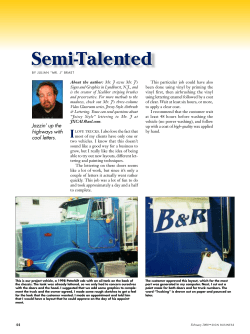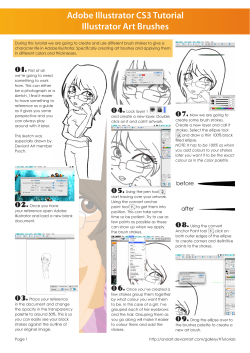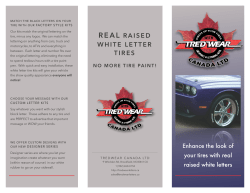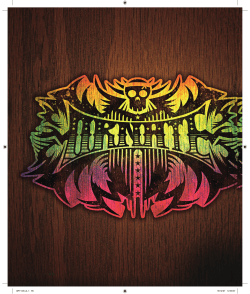
Unit 3 Lettering Lettering Styles
Unit 3 Lettering Lettering Styles Before the invention of printing by Gutenberg in the fifteenth century, all letters were made by hand, and their designs were modified and decorated according to the individual writer's taste. In England these letters became known as Old English. The early German printers adopted the Old English letters, and they are still in limited use. The early Italian printers used Roman letters, which were later introduced into England and gradually replaced the Old English letters. The Roman capitals have come down to us virtually in their original form. A general classification of letter styles is shown in Fig. 4.1. Lettering, not "printing," is the correct term for making letters by hand. Printing means the production of printed material on a printing press. Roman Letters The term Roman refers to any letter that has wide downward strokes and thin connecting strokes, as would result from the use of a wide pen, and the ends of the strokes are terminated with spurs called serifs. Roman letters include the Old Roman and Modern Roman and may be vertical or inclined. Inclined letters are also referred to as italic, regardless of the letter style; those shown in Fig. 4.1 are inclined Modern Roman. Gothic Letters The Text letters shown in Fig. 4.1 are often loosely referred to as Old English, although these and other similar letters, such as German Text, are actually Gothic. German Text is the only form of medieval Gothic in commercial use today. Commercial Gothic is a relatively modern development that originated from the earlier Gothic forms. Also called sans-serif Gothic, this letter is the only one of interest to engineers, Fig. 4.5. It is the plainest and most legible style and is the one from which our single-stroke engineering letters are derived. While admittedly not as beautiful as many other styles, sans-serif letters are very legible and comparatively easy to make. They may also be drawn in outline and filled in. 1 EXTENDED AND CONDENSED LETTERS To meet design or space requirements, letters may be narrower and spaced closer together, in which case they are called compressed or condensed letters. If the letters are wider than normal, they are referred to as extended letters. LIGHTFACE AND BOLDFACE LETTERS Letters also vary as to the thickness of the stems or strokes. Letters having very thin stems are called LIGHTFACE, while those having heavy stems are called BOLDFACE. Standardization of Lettering Reinhardt's development of single-stroke letters was the first step toward standardization of technical lettering. Since that time, however, there has been an unnecessary and confusing diversity of lettering styles and forms. In 1935 the American National Standards Institute suggested letter forms that are now generally considered as standard. Either vertical or inclined letters may be used, but only one style should appear on any one drawing. Background areas between letters in words should appear approximately equal, and words should be clearly separated by a space equal to the height of the lettering. Only when special emphasis is necessary should the lettering be underlined. Uniformity In any style of lettering, uniformity is essential. Uniformity in height, proportion, inclination, strength of lines, spacing of letters, and spacing to look well, and some allowances must be made for errors in 2 perception. Note that in Fig. 4.25 the width of the standard H is less that its height to eliminate a square appearance, the numberal 8 is narrower at the top to give it stability, and the width of the letter W is greater that its height, for the acute angles in the W give it a compressed appearance. Such acut angles should be avoided in good letter design. Uniformity in height and inclination is promoted by the use of light guide lines. Uniformity in strength of lines can be obtained only by the skilled use of properly selected pencils and pens, Fig. 4.10 and Fig 4.11. Stability If the upper portions of certain letters and numerals are equal in width to the lower portions, the characters appear top-heavy. To correct this, the upper portions are reduced in size where possible, thereby producing the effect of stability and a more pleasing appearance, Fig. 4.11. If the central horizontal strokes of the letters B, E, F, and H are placed at mid height, they will appear to be below center. To overcome this optical illusion, these strokes should be drawn slightly above the center. Optical Illusions Good lettering involves artistic design, in which the white and black areas are carefully balanced to produce a pleasing effect. Letters are designed to look well, and some allowances must be made for errors in perception. Note that in Fig. 4.25 the width of the standard H is less than its height to eliminate a square appearance, the numeral 8 is narrower at the top to give it stability, and the width of the letter W is greater than its height, for the acute angles in the W give it a compressed appearance. Such acute angles should be avoided in good letter design. 3 Techniqu e of Lettering Any normal person can learn to letter if a persistent and intelligent effort is made. Although it is true that "practice makes perfect," it must be understood that practice alone is not enough; it must be accompanied by continuous effort to improve. Lettering is freehand drawing and not writing. Therefore, the six fundamental strokes and their direction for freehand drawing are basic to lettering, Fig. 4.15. The horizontal strokes are drawn to the right, and all vertical, inclined, and curved strokes are drawn downward. Good lettering is always accomplished by conscious effort and is never done well otherwise, though good muscular coordination is of great assistance. Ability to letter has little relationship to writing ability; excellent letterers are often poor writers. There are three necessary aspects of learning to letter. 1. Knowledge of the proportions and forms of the letters and the order of the strokes. No one can make a good letter who does not have a clear mental image of the correct form of the letter. 2. Knowledge of composition-the spacing of letters and words. Rules governing composition should be thoroughly mastered. 3. Persistent practice, with continuous effort to improve. First, sharpen the pencil to a needle point; then dull the point very slightly by marking on paper while holding the pencil vertically and rotating the pencil to round off the point. Pencil lettering should be executed with a fairly soft pencil, such as an F or H for ordinary paper; the strokes should be dark and sharp, not gray and blurred. In order to wear the lead down uniformly and thereby keep the lettering sharp, turn the pencil frequently to a new position. In general, draw vertical strokes downward or toward you with a finger movement, and draw horizontal strokes from left to right with a wrist movement without turning the paper. Since practically all pencil lettering will be reproduced, the letters should be dense black. Avoid hard pencils that, even with considerable pressure, produce gray lines. Left-handers All evidence indicates that the left-handed drafter is just as skillful as the right-hander, and this includes skill in lettering. The most important step in learning to letter is learning the correct shapes and proportions of letters, and these can be learned as well by the left-hander as by anyone else. The left-hander does have a problem of developing a system of strokes that seems personally most suitable. The strokes shown in Figs. 4.25 and 4.26 are for right-handers. The lefthander should experiment with each letter to find out which strokes are best. The habits of left-handers vary so much that it is futile to suggest a standard system of strokes for all lefthanders. 4 Guide Lines Fig. 4.18 Extremely light horizontal guidelines are necessary to regulate the height of letters. In addition, light vertical or inclined guide lines are needed to keep the letters uniformly vertical or inclined. Guide lines are absolutely essential for good lettering and should be regarded as a welcome aid, not as an unnecessary requirement. Guide Lines for Capital Letters Guide lines for vertical capital letters are shown in Fig. 4.19. On working drawings, capital letters are commonly made 1/8” high. The vertical guidelines are not used to space the letters-this should always be done by eye while lettering-but only to keep the letters uniformly vertical. Accordingly, they should be drawn at random. Where several lines of letters are to be made, these vertical guide lines should be continuous from top to bottom of the lettered area, as shown. 5 Ames Lettering Guide Fig. 4.24 The Ames Lettering Guide is an ingenious transparent plastic device composed of a frame holding a disk with three columns of holes. The vertical distances between the holes may be adjusted quickly to the desired spacing for guide lines or section lines by simply turning the disk to one of the settings indicated at the bottom of the disk. These numbers indicate heights of letters in thirty-seconds of an inch. Thus, for 1/8" high letters, the No. 4 setting would be used. The center column of holes is used primarily to draw guide lines for numerals and fractions, the height of the whole number being two units and the height of the fraction four units. The No. 4 setting of the disk will provide guide lines for 8" whole numbers, with fractions twice as high, or 4", as shown at (a). Since the spaces are equal, these holes can also be used to draw equally spaced guide lines for lettering or to draw section lines. The Ames Lettering Guide is also available with metric graduations for desired metric spacing. The two outer columns of holes are used to draw guide lines for capitals or lowercase letters, the column marked three-fifths being used where it is desired to make the lower portions of lowercase letters three-fifths the total height of the letters and the column marked two-thirds being used where the lower portion is to be two thirds the total height of the letters. In each case, for capitals, the middle hole of each set is not used. The two-thirds and three-fifths also indicate the spaces between lines of letters. Vertical Capital Letters and Numerals Fig. 4.25 For convenience in learning the proportions of the letters and numerals, each character is shown in a grid six units high. Numbered arrows indicate the order and direction of strokes. The widths of the letters can be easily remembered. The letter 1 or the numeral 1 has no width. The W is 8 units wide (13 times the height) and is the widest letter in the alphabet. All the other letters or numerals are either 5 or 6 units wide, and it is easy to remember the 6unit letters because when assembled they spell TOM Q. VAXY. All numerals except the 1 are 5 units wide. All horizontal strokes are drawn to the right, and all vertical, inclined, and curved strokes are drawn downward, Fig. 4.15. As shown in Fig. 4.25, the letters are classified as straight-line letters or curved-line letters. On the third row the letters 0, Q, C, and G are all based on the circle. The lower portions of the J and U are semi-ellipses, and the right sides of the D, P, R, and B are semicircular. The 8, 3, S, and 2 are all based on the figure 8, which is composed of a small ellipse over a larger ellipse. The 6 and 9 are based on the elliptical zero. The lower part of the 5 is also elliptical in shape. 6 Inclined Capital Letters and Numerals Fig. 4.26 The order and direction of the strokes and the proportions of the inclined capital letters and numerals are the same as those for the vertical characters. Inclined letters are also classified as straight-line or curved-line letters, most of the curves being elliptical in shape. Guide Lines for Whole Numbers and Fractions Complete guide lines should be drawn for whole numbers and fractions. This means that both horizontal and vertical guide lines, or horizontal and inclined guide lines, should be drawn. Fig. 4.27 Draw five equally spaced guide lines for whole numbers and fractions. Thus, fractions are twice the height of the corresponding whole numbers. Make the numerator and the denominator each about three-fourths as high as the whole number to allow ample clear space between them and the fraction bar. 7 If the Ames Lettering Guide, Fig. 4.24, is used with the No. 4 setting of the disk, the same five guide lines, is" 1/8” apart, may be drawn from the central column of holes. Some of the most common errors in lettering fractions are illustrated in Fig. 4.29. Never let numerals touch the fraction bar, (a). Center the denominator under the numerator, (b). Never use an inclined fraction bar, (c), except when lettering in a narrow space, as in a parts list. Make the fraction bar slightly longer than the widest part of the fraction, (d). Spacing of Letters and Words Uniformity in spacing of letters is a matter of equalizing spaces by eye. The background areas between letters, not the distances between them, should be approximately equal. In (a) the actual distances are equal, but the letters do not appear equally spaced. At (b) the distances are intentionally unequal, but the background areas between letters are approximately equal, and the result is an even and pleasing spacing. Space words well apart, but space letters closely within words. Make each word a compact unit well separated from adjacent words. For either uppercase or lowercase lettering, make the spaces between words approximately equal to a capital O. Avoid spacing letters too far apart and words too close together, as shown at (b). Samples of good spacing are also shown in Fig. 4.17. 8
© Copyright 2025





















